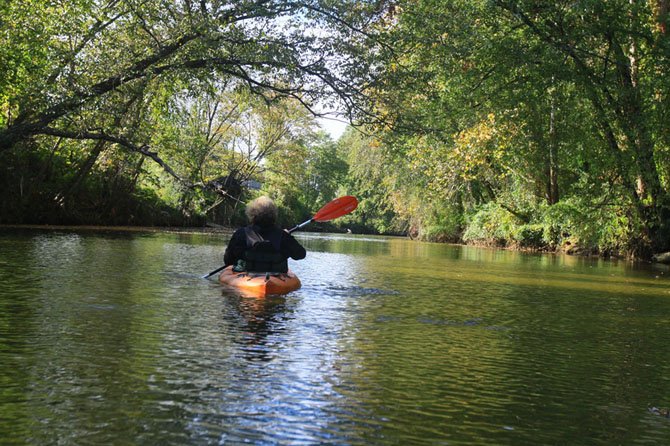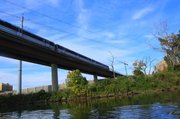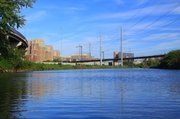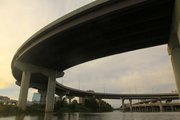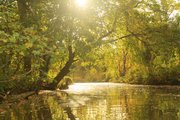Recreational opportunity abounds in the northern border of the Mount Vernon District in the form of urban kayaking, canoeing, paddle boarding and perhaps even wind surfing on the slowly moving flat water that is within the confines of the Hunting Creek, Quander Brook and Cameron Run watershed. On Monday, Oct. 20, in the early afternoon of a mild, partly sunny day, I joined my friend Lee Ranta from Fort Washington, Md. on a kayaking adventure on a stretch of water between the George Washington Parkway bridge crossing Hunting Creek and the Beltway bridge crossing Cameron Run above Telegraph Road.
Amid the stark contrast between raw nature and the infrastructure of highway, metro rail, towering utility structures and the cityscape outlines of the Eisenhower Valley and Huntington Road development, are stretches of serene flat water environments where all manner of aquatic life abounds. Hours of pleasure awaits those seeking some time to connect with nature or to just get a good workout paddling this course between the two bridges. On this day, my friend and I, after much study and examination of the south bank shoreline, decide to try and launch from a place on the banks of Cameron Run in the area of Huntington Park. The park lacks any kind of launch facility for small watercraft thus making it a challenging effort to enter the water, especially for two older gentlemen that aren’t as limber or fleet of foot as they once were.
The first thing one can notice upon entering the water is the abundance of fish and minnows easily viewed in the shallow clear waters. This is observational evidence of an overall good water quality with the only obvious pollution being an abundance of unsightly trash in the form of plastic containers and bags along many stretches of the banks. Someone has made efforts to clean up this form of unsightly trash as there were several locations along the banks where there were large collections of filled plastic trash bags waiting to be collected. How frustrating it must be to collect so much unwanted trash to only have more flushed into the system over and over again as it originates from nearby urban streets into stormwater drains leading to these waters.
Once in mid stream, our attention is drawn to birds like the belted kingfishers with their distinct call as they fly between perches on tree branches hanging over the water. Gliding directly above is an American Osprey looking for an opportunity to dive in and capture a meal. Rafts of ducks are scattered throughout the calm waters. Canada geese are standing on gravel bars next to the shoreline or amid shallow areas. Egrets and great blue herons are wading in marshy areas in search of minnows. Cormorants are perched on logs with their wings stretched out in the sun to let their wing feathers dry. Most of these birds go about their business, undisturbed by our presence as we quietly glide by.
We first follow the water to the west from our point of disembarking going beneath the metro rail line between Huntington and Eisenhower stations then beneath the massive electrical transmission lines going into Alexandria. The walls of the sound barriers are on the north side and keep out most of the noise of the traffic rumble on the other side. Metro trains pass above and looking up one sees riders looking down at the water and the two lone kayakers below. As we approach the bridge at Telegraph Road, pedestrians on the recently completed walkway and bicycle path coming from Eisenhower Valley are seen trekking towards Huntington Road. Some wave and stare down at us from above as we pass below.
Beyond the bridge at Telegraph Road is an especially quiet stretch of water surrounded by parcels of wooded land. Trees like river birch and sycamore are noticeable along the shoreline. Farther away from the shore are other mature trees common to eastern forests like maple, oaks and hickory. Tracks from raccoons, deer and other mammals can be seen in the mud and sand along the banks. A lone aquatic turtle is resting on a log taking advantage of the sunny location to warm itself up. The presence of birds in and out of the water and among the trees is noticeable all along this stretch. How fortunate we are to glide silently through this beautiful setting visually unaware that we are surrounded on either side beyond the wooded stretches by massive assemblages of concrete and steel. We approach the Beltway bridge crossing over Cameron Run where it enters the Eisenhower Valley but are stopped by water too shallow to continue on without having to disembark and portage to a more navigable spot. Knowing that only a short distance ahead is a series of step dams we decide to turn around and explore the waterway to the east of where we made our entry into the water at Huntington Park.
The banks along much of the water are lush in vegetation. Jerusalem artichokes are in full bloom with their large bright and cheery yellow flowers. Wild asters are blooming in abundance and there are still in bloom the purple flowers of pickerel weed in marshy areas along with the mature narrow leaf cattails emerging from shallow marshes. These native plants are being challenged by invasive species like phragmites, Japanese knot weed and porcelain berry and Asian bittersweet vines competing for space and sunlight along the shoreline.
Gliding east, the beltway is on our left. The previous concrete sound barrier walls change to metal walls which are not as effective in keeping out the noise but still the noise is not as intolerable as it would be without any walls at all. We pass by the Riverside apartments with its huge oxidizing steel bulkhead on the south bank . Stormwater pipes are observed poking through the steel walls of the bulkhead draining directly into the waters carrying parking lot sand, grit, and automotive residues along with discarded trash into the waterway. Perhaps one day in the future, should this area be redeveloped, a new system that captures trash and treats the water from all pollution due to this imperviousness can replace the aging and out of date infrastructure currently in place. Just past the Riverside apartments is the Ourisman Dodge dealership with many shiny new cars sitting on bare ground lots just yards away from the edge of the water.
High above are large systems of complex structures composed of concrete and steel engineered to connect traffic from Alexandria and the beltway to the west onto the Wilson Bridge and to U.S. Route 1. These are truly a form of surreal complexities from life in the 21st century. This part of the journey is a dreamlike passage through the interface of nature and civilization. Within moments we are passing under the U.S. Route 1 bridge with rush hour traffic above. This is perhaps the safest crossing ever achieved during rush hour on this infamous highway.
A short distance to the right is where Quander Brook empties into the place where the waters of Cameron Run and Hunting Creek are intertwined. The channel is navigable to the south passing behind the Hampton Inn and the adjacent office building before becoming too shallow just below the crossing at Fort Hunt Road. The banks are lush with growth and there is a mix of marsh vegetation on the sides of the brook. Our presence in this narrow stretch of water sends ducks and herons into flight with them circling around and landing back in Hunting creek behind us to the north. This lower reach of Quander Brook is particularly strewn with plastic debris giving testimony to the out-of-date and inadequate stormwater facilities along U.S. Route 1 to the south leading to the headwaters of Quander Brook in the residential community of Spring Bank where I live. The old infrastructure serves a purpose to direct water from U.S. Route 1 and hundreds of acres of impervious parking for commercial and residential areas directly into this watershed but also acts as a direct conduit for transporting trash thoughtlessly disposed of by people and commercial establishments not assuming the personal responsibility of properly managing the wastes they create or generate through manufacturing, consumption and final disposal. Though this unsightly and unwanted form of pollution in this environment is ever present in spite of annual cleanup attempts to remove such debris from our waterways, there is still beauty among the thriving natural components of this desecrated ecosystem.
The real danger in the untreated storm water emanating from the old storm water infrastructure on U.S. Route 1 is in the form of the unseen chemical pollutants washed into the system that originates from automobile use and careless citizens and business owners in managing dangerous products used in the home or the workplace. This more ubiquitous and unseen pollution enters these waterways from all over the district and especially in the older developed areas of the county lacking the up-to-date infrastructure that intercepts solid waste trash and treats stormwater runoff before returning it to local streams. Once transported by Quander Brook into Hunting Creek the trash and chemical pollution exits this waterway under the bridge crossing at the George Washington Memorial Parkway and enters the Potomac River estuary flowing south around Belle Haven Park and into Dyke Marsh.
After leaving Quander Brook and paddling awhile around the perimeter of Hunting Creek with the Belle Haven Country Club and Golf Course on the south bank, my friend and I turn west again as it is getting late and there is only about two hours of light before dusk. The light and shadows are ever changing at this time as the sun lowers in the west and we are again passing beneath bridge structures and the imposing yet geometrically and aesthetically pleasing structures of the highway flyovers and ramps.
